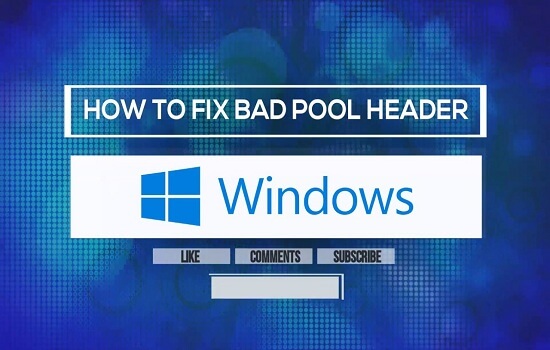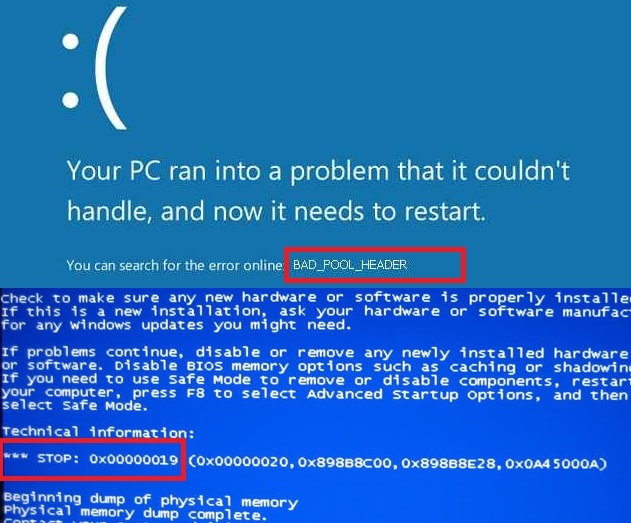

- #Bad pool header blue screen windows 7 drivers
- #Bad pool header blue screen windows 7 driver
- #Bad pool header blue screen windows 7 full
- #Bad pool header blue screen windows 7 pro
- #Bad pool header blue screen windows 7 windows 8.1
#Bad pool header blue screen windows 7 driver
How long should I keep Driver Verifier enabled for?
#Bad pool header blue screen windows 7 windows 8.1
Note that Safe Mode for Windows 8/8.1 is a bit different, and you may need to try different methods:ĥ Ways to Boot into Safe Mode in Windows 8 & Windows 8.1 Choose the restore point you created earlier. Once in Safe Mode - Start > type "system restore" without the quotes. If your OS became corrupt or you cannot boot into Windows after disabling verifier via Safe Mode: To turn off Driver Verifier, type in cmd "verifier /reset" without the quotes. Once in Safe Mode - Start > Search > type "cmd" without the quotes. Boot into Safe Mode by repeatedly tapping the F8 key during boot-up. If this happens, do not panic, do the following: After enabling Driver Verifier and restarting the system, depending on the culprit, if for example the driver is on start-up, you may not be able to get back into normal Windows because Driver Verifier will detect it in violation almost straight away, andĪs stated above, that will cause / force a BSOD.
#Bad pool header blue screen windows 7 drivers
When Driver Verifier is enabled, it is monitoringĪll 3rd party drivers (as we have it set that way) and when it catches a driver attempting to do this, it will quickly flag that driver as being a troublemaker, and bring down the system safely before any corruption can occur. Happens, system corruption occurs if allowed to continue. To expand on this a bit more for the interested, specifically what Driver Verifier actually does is it looks for any driver making illegal function calls, causing memory leaks, etc. If Driver Verifier finds a violation, the system will BSOD. Important information regarding Driver Verifier: Check EVERY box that is NOT provided by Microsoft / Microsoft Corporation. This will sort all of the drivers by the provider.Ħ. Select - "Select driver names from a list"ĥ.
#Bad pool header blue screen windows 7 full
Select - "Select individual settings from a full list"Ĥ. Select - "Create custom settings (for code developers)"Ģ. Start > type "verifier" without the quotes > Select the following options -ġ.

Windows 7 - START | type create | select "Create a Restore Point" Vista - START | type rstrui - create a restore point Kernel-mode components can cause system corruption or system failures as a result of an improperly written driver, such as an earlier version of a Windows Driver Model (WDM) driver.Įssentially, if there's a 3rd party driver believed to be at issue, enabling Driver Verifier will help flush out the rogue driver if it detects a violation.īefore enabling Driver Verifier, it is recommended to create a System Restore Point: If the above fails, enable Driver Verifier:ĭriver Verifier is included in Windows 8/8.1, 7, Windows Server 2008 R2, Windows Vista, Windows Server 2008, Windows 2000, Windows XP, and Windows Server 2003 to promote stability and reliability you can use this tool to troubleshoot driver issues.
#Bad pool header blue screen windows 7 pro
Uninstall Malwarebytes Pro as it may be causing corruption.Ģ. This indicates that a pool header is corrupt.ġ. I'm at my wits end!!!! Please can anyone advise me on what I can do more or what could be the problem? Any information whatsoever would be greatly appreciated Thanking you in advance.The attached DMP file is of the BAD_POOL_HEADER (19) bug check. Normally I'm computer savvy and have no problem with a minor problem or two, but I gotta admit, this has got me stumped! No matter what I do it doesn't seem to make a difference I manually updated each device driver through device manager. I ran Memory Diagnostic tool which excluded any problem with memory or ram. I ran RegCure Pro which found many registry problems and apparently all is well with that too. I scanned my computer with Anti-Virus software. which found some errors but apparently rectified them. At first I ran sfc.scannow through cmd.exe. I have searched for hours and hours through websites and forums, here are the steps I've taken. So as a result, it's getting tedious to use it at all. When I run it normally, the BSoD appears after a mere 4-5 mins and will restart itself again.

It titles BAD POOL HEADER at the top of the screen and lists a series of error codes before restarting itself.Īt first when my laptop would restart it would be fine for a while but now I can only use it in safe mode if for a brief time. I've been getting a BSoD on my Samsung Notebook Model # NP - R530 which is running Windows 7.


 0 kommentar(er)
0 kommentar(er)
